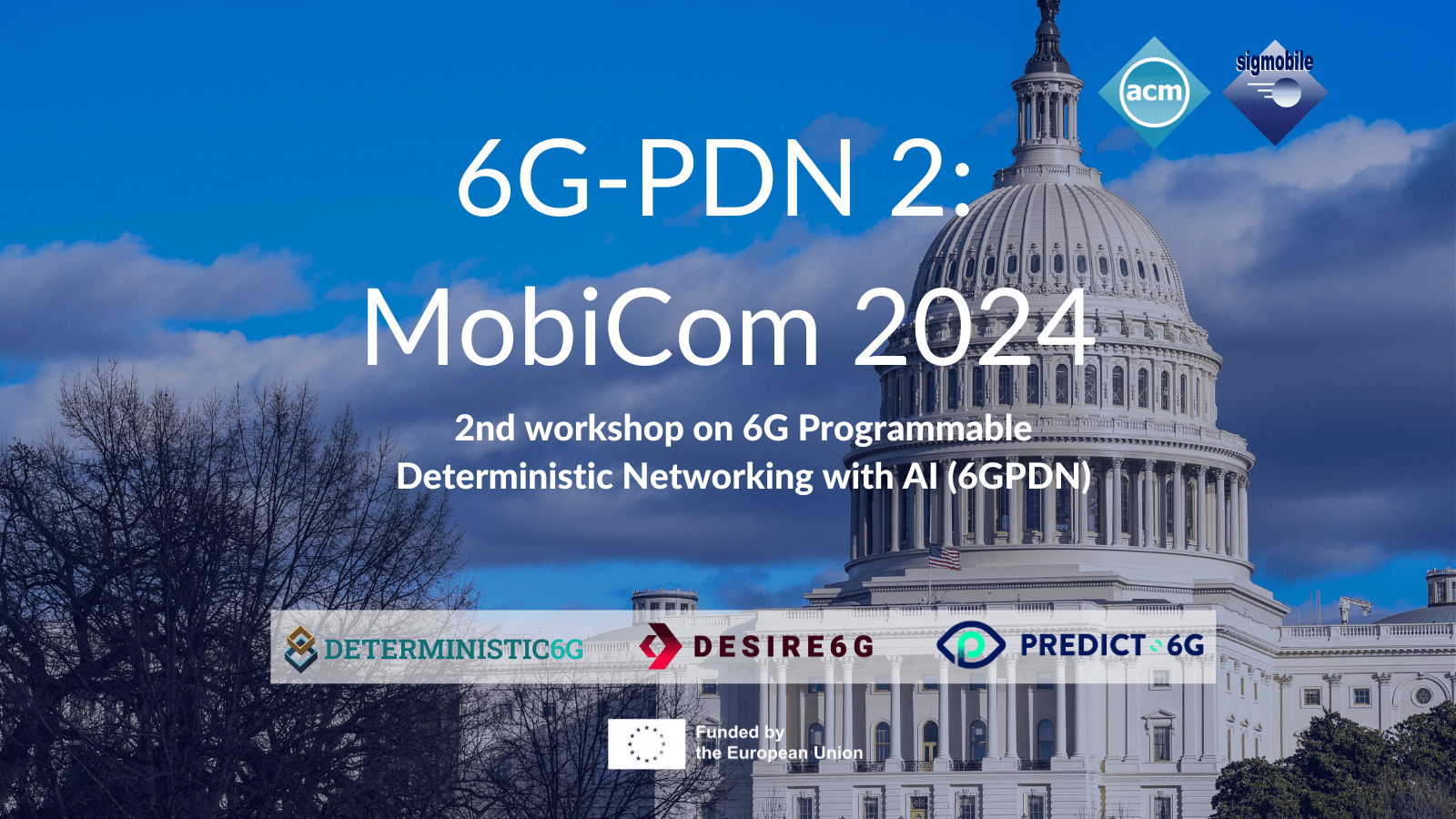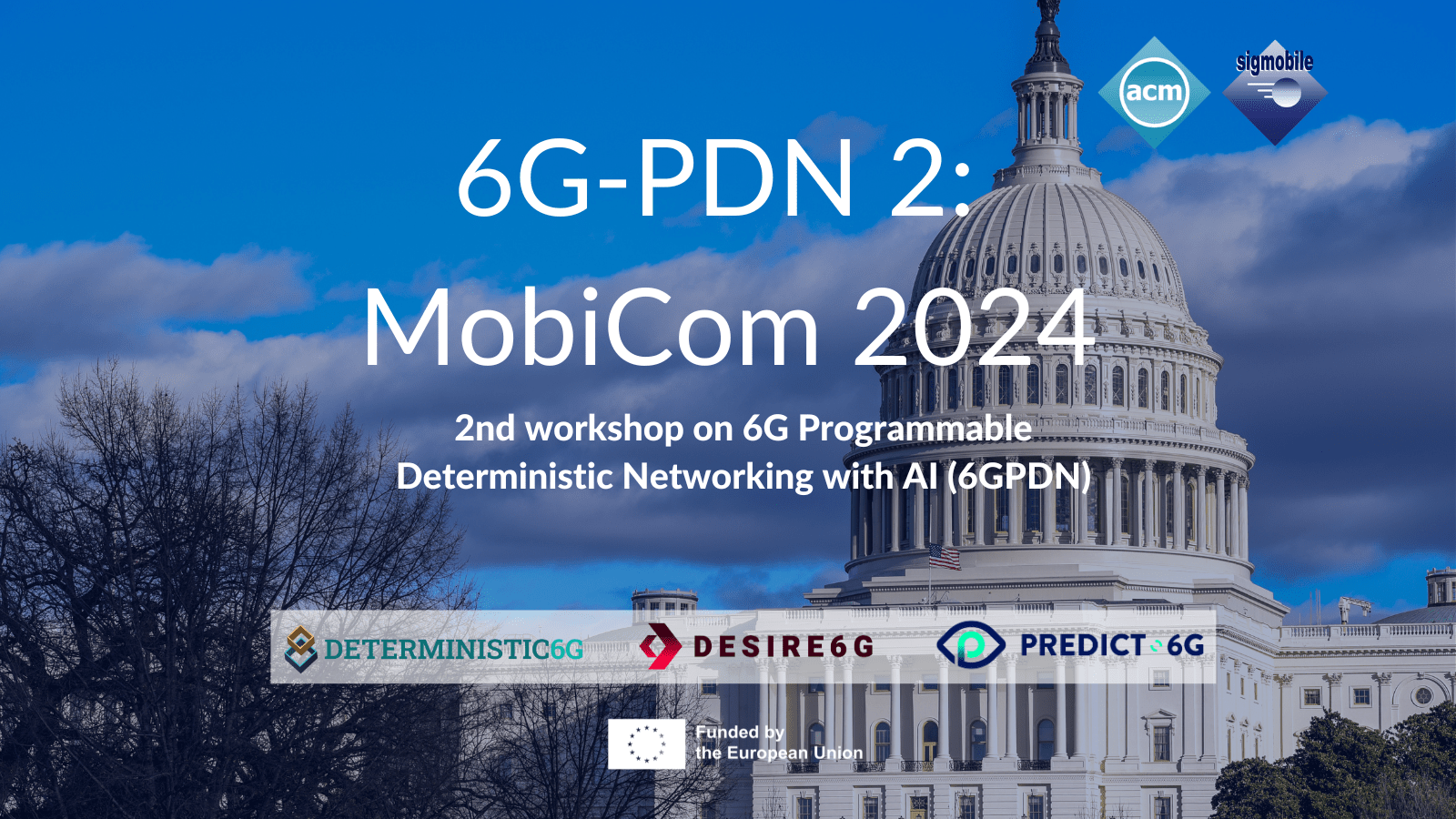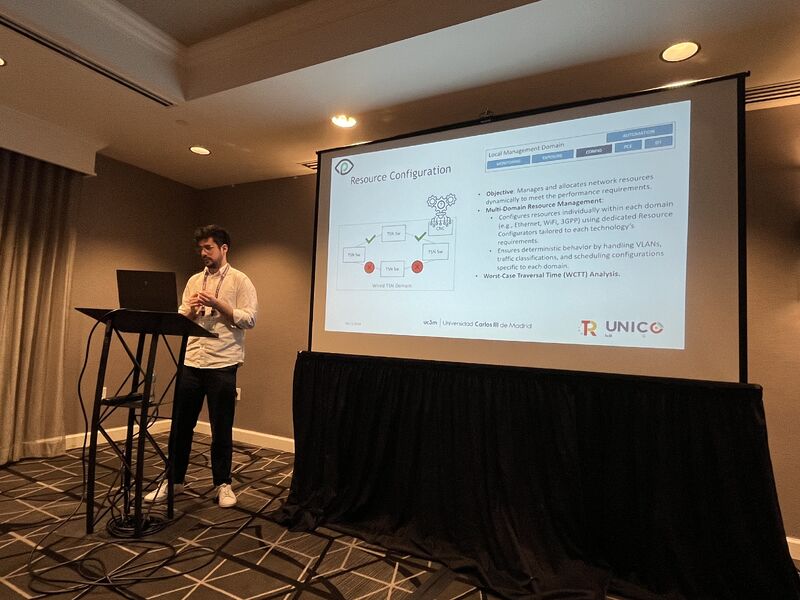UPCOMING EVENTS
As PREDICT-6G enters its final months, the consortium partners are showcasing the results of the use cases and presenting the latest publications and papers at various events over the coming months. Here is a list so you don’t miss any of the events taking place in 2025.
MPLS & SRv6 AI Net World Congress
The 2025 edition of MPLS & SRv6 AI Net World Congress will take place on 25 - 27 March in Paris, France. The 2025 conference programme will focus on the impact of AI & ML on current infrastructures and services.
Experts will discuss intelligent computing networks, digital twins, software engineering and automation aspects. A large part will be dedicated to IPv6 networks and SRv6 deployments: inter-cluster connectivity, deterministic path placement, IPM hardware connectivity and other key developments. Other sessions will cover IP/optical networks, routing issues, 5G/6G & the edge, latency and security.
Luis Miguel Contreras, technology expert at the Global CTIO Unit from Telefónica, PREDICT-6G partner, will be one of the speakers at the conference. He will participate in the Latency and Performance Measurement session to address the new considerations, such as latency and jitter, required by new services such as VR and AR.
SNS projects join forces in the AI and Security Webinar
In April 2025, PREDICT-6G will participate with several SNS projects in the “AI and Security” webinar. Organised by ELASTIC and CONFIDENTIAL-6G, the online event addresses various aspects of AI and security from different perspectives.
The webinar comprises three main sessions, namely: Privacy and Security in Federated and Distributed AI; AI and Security for Predictive and Resilient Networking; and, Security and Privacy Management in Next-Generation Network Orchestration.
PREDICT-6G partner, Fotis Foukalas from Cognnin, will deliver a presentation titled “Threats and Security Enablers for Predictive 6G Networks”.
Stay tuned for more information!
EuCNC 2025
The 2025 EuCNC & 6G Summit will take place on 3 - 6 June in Poznan, Poland. Combining two successful telecoms conferences: ECNC (European Conference on Networks and Communications), supported by the European Commission, and the 6G Summit, originating from Finland’s 6G Flagship programme, the event is now one of the largest in the sector.
Under the theme 'Towards the 6G World', EuCNC will bring together more than 1000 delegates from over 40 countries around the world and an exhibition with more than 50 exhibitors to demonstrate the technology being developed in this area, notably through research projects from EU R&I programmes. One of these projects will be PREDICT-6G, as we are returning for the third year in a row.
Save the date and stay tuned for more information on this event!
If you want to stay updated about PREDICT-6Gt, subscribe to our newsletter and follow us on Twitter, LinkedIn and Bluesky!
PREDICT-6G at the MWC 2025
MWC Barcelona, the largest and most influential event in the connectivity sector, was held on 03-06 March 2025. It brought together more than 109k attendees from 205 countries and territories and over 2,900 exhibitors, among which was PREDICT-6G consortium member, InterDigital. As in previous years, InterDigital had a strong presence at MWC, with a stand that included, among other things, several demos showing how innovation powers connected experiences at work, at play and at rest.
InterDigital's booth showcased cutting-edge research and industry collaborations, highlighting the potential of 6G to integrate sensor data and AI with wireless communications, pioneering immersive video experiences and solutions to reduce power consumption across devices, and tangible applications of AI to enhance and improve the variety of content and services delivered over wireless. One of these contributions is the PREDICT-6G demonstration called “Novel Data Plane Concept for Deterministic Networking in an ISAC Setting”, which was part of the ‘Integrated Sensing and Communication’ corner of InterDigital’s booth.

Dr. Sebastian Robitzsch from InterDigital, responsible for the standardisation of PREDICT-6G, showed the project demo to the visitors of the MWC. This demo shows how Integrated Sensing and Communication (ISAC)-enabled 6G networks, supported by AI, can enable an autonomous robot to navigate seamlessly through a smart factory environment, avoiding collisions with objects in its path. ISAC uses sensor data from base stations and user devices to identify a wide range of factors to provide optimal service. The approach also ensures reliable and mission-critical delivery of measurement results to applications by leveraging deterministic networking. It also introduces Protocol Data Unit Set-like support, facilitating end-to-end handling of all IP traffic across multi-domain and multi-technology environments.
If you want to stay updated about PREDICT-6Gt, subscribe to our newsletter and follow us on Twitter, LinkedIn and Bluesky!
Integration Week at 5Tonic Open Lab
From 20 to 24 January 2025, PREDICT-6G held the first Integration Week of the project at the 5Tonic Open Lab in Madrid.
In parallel with the first plenary meeting of 2025, held at the Universidad Carlos III de Madrid (UC3M), PREDICT-6G research and technical partners immersed into a week of work focused on implementing the theoretical framework developed in the past years. The activities were carried out in the 5Tonic Open Lab in Madrid, one of two Open Labs where PREDICT-6G use cases are being tested..
In the final stages of the project, the priority is to seamlessly integrate the various elements comprising the deterministic, secure, modular and interoperable 6G network of PREDICT-6G. For this purpose, partners from Universidad Carlos III de Madrid, Nextworks, Atos, SIMAVI, Universitat Politècnica de Catalunya, InterDigital, Ericsson and Telefónica worked together in the MDP and AICP integration and its application in deterministic communications and smart manufacturing.
As part of the Integration Week activities, some of the partners recorded short tutorials on the work developed during these days.
AICP Integration
Alejandro Calvillo, researcher at UC3M, explains what they have done in terms of AICP integration
Smart Factory use case
Miguel Ángel López Serrano, System Manager at Ericsson, explains the progress they are making in the 'Smart Factory' Use Case.
Multi-Domain use case
David Rico, a PhD student and researcher at UC3M, explains the progress they are making in the 'Multi-Domain' Use Case.
If you want to stay updated about PREDICT-6Gt, subscribe to our newsletter and follow us on Twitter, LinkedIn and Bluesky!
PREDICT-6G first plenary meeting of 2025
The Universidad Carlos III de Madrid (UC3M) hosted the first PREDICT-6G Plenary Meeting of 2025. The consortium partners met in Madrid (Spain) for three days to review the status of the project and align on the work to be done in the remaining six months of the project.
On the 20-22 January 2025, the PREDICT-6G consortium held its latest plenary meeting in the UC3M premises. The agenda started with an overview of the project status by the Technical Director. The consortium discussed the progress made so far in terms of milestones, deliverables and KPIs.
One of the highlights of the meeting was the discussion of the latest developments regarding the AI-driven Multi-stakeholder Inter-domain Control-Plane (WP3) and the Multi-technology Multi-domain Data Plane (WP2), as well as their convergence. It was shown that PREDICT-6G is ready to test the local path calculation that enables E2E deterministic service provisioning and Wi-Fi TSN resource configuration.

During the following two days, all Work Package Coordinators, supported by the Task Leaders, presented an overview of their activities and achievements, with a special focus on the technical parts that need to be finalised and integrated in the coming months. There was also time for less technical aspects, in particular, the innovation workshop run by Intel, PREDICT-6G Innovation Manager.
The plenary session was very productive. By June 2025, PREDICT-6G will have its secure, modular, interoperable and extensible deterministic 6G network and management framework finished and ready to be presented.
If you want to stay updated about PREDICT-6Gt, subscribe to our newsletter and follow us on Twitter, LinkedIn and Bluesky!
PREDICT-6G at 2024 IEEE Globecom
The 2024 IEEE Global Communications Conference (GLOBECOM) was held in Cape Town, South Africa, from 8-12 December 2024. It is one of the IEEE Communications Society’s two flagship conferences dedicated to driving innovation in nearly every aspect of communications. Under the theme ‘Connecting the Smart World Across Africa’, the 2024 edition featured a comprehensive and high-quality technical programme including 13 symposia and a variety of tutorials and workshops.
PREDICT-6G presented the paper ‘Standardisation Assessment of a Digital Twin-Based Multi-Domain Deterministic Communications System’ during the session 6GArch: Workshop on 6G Architecture. This workshop aims to explore architectural innovations and provide a collaborative platform to shape the future of mobile telecommunications systems.
The paper presented is a joint collaboration of several partners of the PREDICT-6G consortium: InterDigital, Carlos III University of Madrid, Politecnico di Torino, Universitat Politècnica de Catalunya, Nextworks, Telefónica, Nokia and Intel; led by Sebastian Robitzsch, PREDICT-6G standardisation coordinator.
You can read the paper here.
If you want to stay updated about PREDICT-6Gt, subscribe to our newsletter and follow us on Twitter, LinkedIn and Bluesky!
A European Vision for 6G
The "European Vision for the 6G Network Ecosystem" white paper, authored by the 6G-IA Vision Working Group, of which PREDICT-6G is an active member, was published in November 2024.
The paper outlines the ambitious trajectory for developing, standardising, and implementing 6G networks, targeted for a commercial rollout by 2030. As the world prepares for the next leap in communication technology, Europe is a driving force in the future 6G networks, proactively addressing the technological, societal, and sustainability challenges.
What Makes 6G Different?
6G promises to revolutionise how we connect, communicate, and interact with the world around us. Integrating Artificial Intelligence (AI) will enable smarter and more responsive systems, whilst advanced technologies, such as sensing and communications (ISAC), will allow 6G devices to go beyond mere communication to sense their surroundings for real-time applications such as autonomous driving and healthcare monitoring.
"Sustainable 6G and 6G for sustainability"
6G aims to reduce the environmental impact by improving energy efficiency and incorporating circular economy principles. 6G networks will be sustainable by design while helping other industries reduce their carbon footprints. Addressing the socioeconomic and environmental challenges through advanced connectivity is a priority.
Groundbreaking innovations
Europe’s vision for 6G identifies six key areas of innovation:
- Immersive Experiences: attending meetings or events will feel like being onsite, thanks to augmented and virtual reality powered by ultra-fast, low-latency networks.
- Collaborative Robots (CoBots): robots will work alongside humans in farms, factories or hospitals, using real-time communication and AI to enhance efficiency and safety.
- Surroundings awareness: 6G enables scene analysis, supporting safer and smarter mobility, by avoiding collisions or improving traffic flow.
- Digital Twins: real-time, interactive virtual replicas of physical systems, such as factories or cities, will enable better monitoring, control, and simulations in real time.
- Ubiquitous Connectivity: 6G aims to connect even the most remote areas, ensuring everyone can access the digital world.
- Trustworthiness: enhanced privacy, security and reliability will enable applications like precision healthcare and public safety.
Europe’s Leadership in 6G Development
The paper stresses the importance of global consensus on 6G standards while acting locally. By combining cutting-edge R&D with a focus on sustainability and inclusivity, Europe aims to lead the global race to 6G while fostering positive impacts across industries and communities.
The journey to 6G is about more than just faster internet speeds. It is about creating smarter, greener, and more inclusive technologies that transform industries and improve lives. As Europe paves the way, the focus remains on collaboration, innovation, and ensuring that 6G serves as a tool for positive change across the globe.
The future of connectivity is closer than you think!
If you want to stay updated about PREDICT-6Gt, subscribe to our newsletter and follow us on Twitter, LinkedIn and Bluesky!
PREDICT-6G attends the 'Más allá del Horizonte' conference
The 12th Conference of the European Union Framework Programme for Research and Innovation in Spain, Horizon Europe: 'Más allá del Horizonte' (Beyond the Horizon), took place on 28 November 2024 in Oviedo, Spain.
The main objective of the conference was to analyse the functioning of Horizon Europe and its main initiatives in Spain. The conference also reviewed the results of Spain's participation in the programme in order to draw conclusions that will allow Spanish organisations to improve their participation strategies and positioning in Europe.
During the conference, there was an exhibition of posters from projects coordinated by Spanish organisations funded by Horizon Europe. PREDICT-6G, coordinated by the University Carlos III of Madrid, had the pleasure of presenting a poster in this exhibition, within the 'Digital, Industry and Space' cluster.

You can watch a video summary of the conference here.
The Conference of the European Union Framework Programme for Research and Innovation in Spain, Horizon Europe is organised by the CDTI, in collaboration with the Spanish Ministry of Science, Innovation and Universities, the European Commission, Oviedo City Council and Sekuens.
MobiCom 2024: 2nd workshop on ‘6G Programmable Deterministic Networking with AI’
The 30th Annual International Conference on Mobile Computing and Networking (MobiCom 2024) was held in Washington DC, USA from 18-22 November 2024. For the second year in a row, PREDICT-6G, DESIRE6G and DETERMINISTIC6G participated in the conference as co-organisers of the 2nd Workshop on "6G Programmable Deterministic Networking with AI" (6G-PDN 2).
The objective of this workshop was to discuss the roadmap and challenges in the technology areas of deterministic communications and deep network programmability in 6G to support future end-to-end time-critical applications. It brought together researchers from academia and industry to present new ideas and technical solutions in these areas, contributing to the advancement of 6G network research.
Keynote speakers at the workshop were Amir Gomroki, Head of 5G for North America and 5G-ACIA Ambassador for Ericsson Research, and Ashutosh Dutta, Senior Scientist, 5G Chief Strategist at Johns Hopkins University Applied Physics Laboratory and Director of the Doctor of Engineering Programme at Johns Hopkins University.

As a result of an open call for papers, the selected authors discussed in depth various aspects of deterministic networks:
- Experimental Evaluation of a Multi-Domain TSN Scenario in Industry 4.0, first author: David Rico-Menéndez (University Carlos III Madrid).
- Routing-Aware Shaping for Feasible Multi-Domain Determinism, first author: Andrea Francini (Nokia Bell Labs).
- Environmental-aware Reinforcement Learning-based Scheduler for Trustworthy 6G in the Factory Floor, first author: Fjolla Ademaj-Berisha (Silicon Austria Labs GmbH).
- Lightweight INT on the Tofino programmable switch, first author: Angelos Dimoglis (University of Amsterdam).
- An Architectural Framework for 6G Network Digital Twin, first author: Zhiheng Yang (University of Amsterdam).
- Artificial Intelligence Control Plane for Deterministic Networks Proof-of-Concept, first author: Alejandro Calvillo-Fernandez (University Carlos III Madrid)
"At the 6G-PDN-II workshop, I learned about different perspectives on the next 6G network architectures. The most fascinating aspect was how dynamic resource configuration will shape the adaptability and efficiency of future 6G networks. Special thanks to Chrysa Papagianni and Fjolla Ademaj-Berisha for their exceptional leadership as chairs", states Alejandro Calvillo-Fernandez.
ACM MobiCom 2024 is the thirtieth in a series of annual conferences sponsored by ACM SIGMOBILE dedicated to addressing the challenges in the areas of mobile computing and wireless and mobile networking. The MobiCom conference series serves as a highly selective, premier international forum addressing networks, systems, algorithms, and applications that support mobile computers and wireless networks.
If you want to stay updated about PREDICT-6Gt, subscribe to our newsletter and follow us on Twitter, LinkedIn and Bluesky!
MobiCom 2024: 2nd workshop on ‘6G Programmable Deterministic Networking with AI’
The 30th Annual International Conference on Mobile Computing and Networking (MobiCom 2024) was held in Washington DC, USA from 18-22 November 2024. For the second year in a row, PREDICT-6G, DESIRE6G and DETERMINISTIC6G participated in the conference as co-organisers of the 2nd Workshop on "6G Programmable Deterministic Networking with AI" (6G-PDN 2).
The objective of this workshop was to discuss the roadmap and challenges in the technology areas of deterministic communications and deep network programmability in 6G to support future end-to-end time-critical applications. It brought together researchers from academia and industry to present new ideas and technical solutions in these areas, contributing to the advancement of 6G network research.
Keynote speakers at the workshop were Amir Gomroki, Head of 5G for North America and 5G-ACIA Ambassador for Ericsson Research, and Ashutosh Dutta, Senior Scientist, 5G Chief Strategist at Johns Hopkins University Applied Physics Laboratory and Director of the Doctor of Engineering Programme at Johns Hopkins University.

As a result of an open call for papers, the selected authors discussed in depth various aspects of deterministic networks:
- Experimental Evaluation of a Multi-Domain TSN Scenario in Industry 4.0, first author: David Rico-Menéndez (University Carlos III Madrid).
- Routing-Aware Shaping for Feasible Multi-Domain Determinism, first author: Andrea Francini (Nokia Bell Labs).
- Environmental-aware Reinforcement Learning-based Scheduler for Trustworthy 6G in the Factory Floor, first author: Fjolla Ademaj-Berisha (Silicon Austria Labs GmbH).
- Lightweight INT on the Tofino programmable switch, first author: Angelos Dimoglis (University of Amsterdam).
- An Architectural Framework for 6G Network Digital Twin, first author: Zhiheng Yang (University of Amsterdam).
- Artificial Intelligence Control Plane for Deterministic Networks Proof-of-Concept, first author: Alejandro Calvillo-Fernandez (University Carlos III Madrid).
ACM MobiCom 2024 is the thirtieth in a series of annual conferences sponsored by ACM SIGMOBILE dedicated to addressing the challenges in the areas of mobile computing and wireless and mobile networking. The MobiCom conference series serves as a highly selective, premier international forum addressing networks, systems, algorithms, and applications that support mobile computers and wireless networks.
If you want to stay updated about PREDICT-6G, subscribe to our newsletter and follow us on Twitter and LinkedIn!
PREDICT-6G at 6G + Chips workshop
On the 20th of November 2024, experts from the mobile networks and electronics gathered in the 6G + Chips workshop. Organised by Cognnin, partner in PREDICT-6G, the online event was the perfect platform to share insights on the progress towards 6G mobile networks and Chipsets. Due to its fundamental role in both industries, Artificial Intelligence was at the forefront of the discussions on how it can be best leveraged for enabling new applications and leading the way for advanced communications and electronics systems.
The workshop was moderated by Fotis Foukalas from Cognnin. Moreover, Prof. Antonio de la Oliva, PREDICT-6G coordinator, was one of the speakers in the Networks Architecture session. The UC3M professor showcased PREDICT-6G’s concept on the network architecture with a presentation titled “Multi-domain, multi-technology deterministic data plane: the PREDICT-6G approach”.
The agenda also featured sessions on RF and channel modeling, Radio Access Technologies, PHY/MAC mechanisms and Edge Computing.
You can see the presentation here.
If you want to stay updated about PREDICT-6Gt, subscribe to our newsletter and follow us on Twitter, LinkedIn and Bluesky!




















